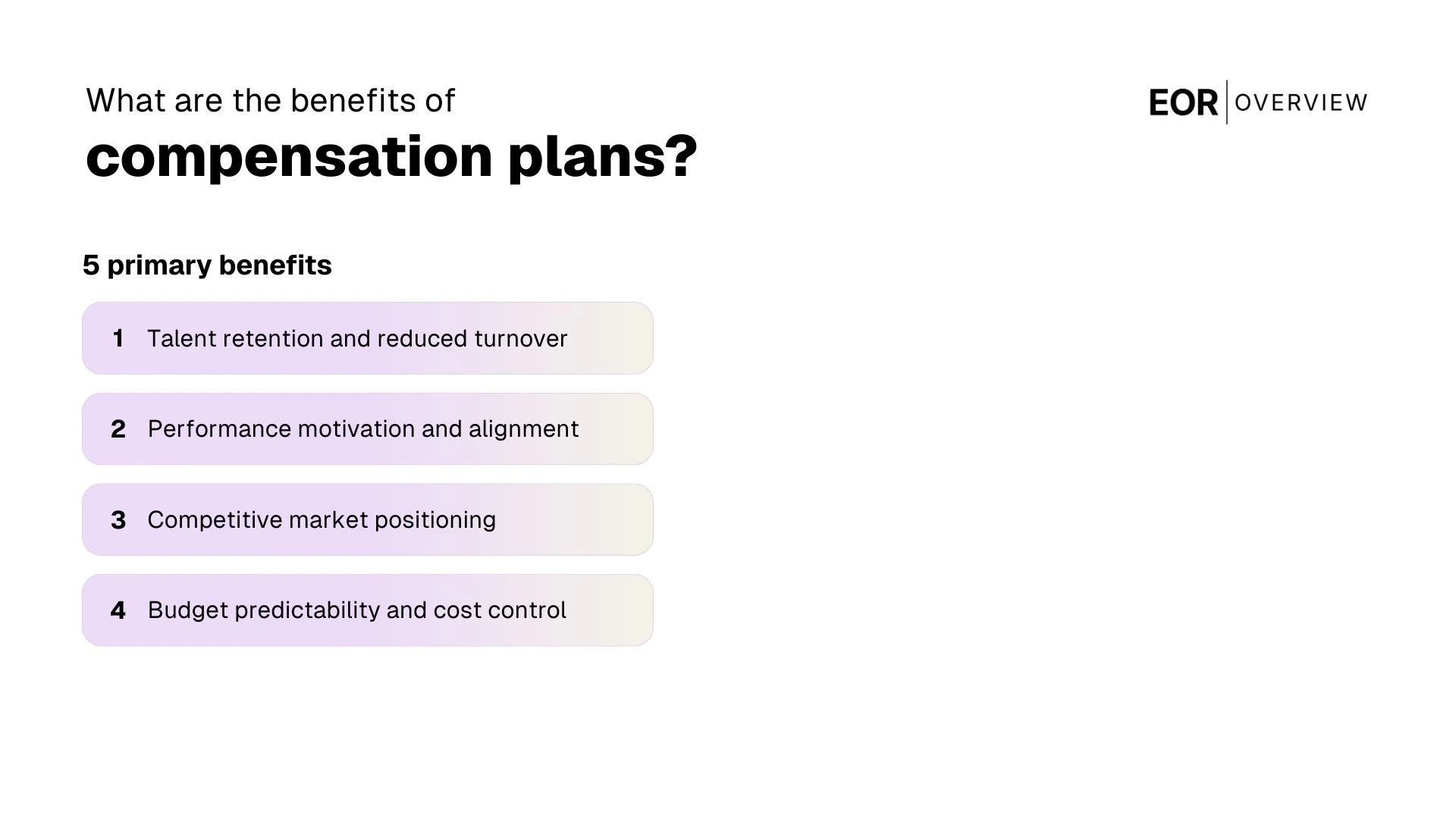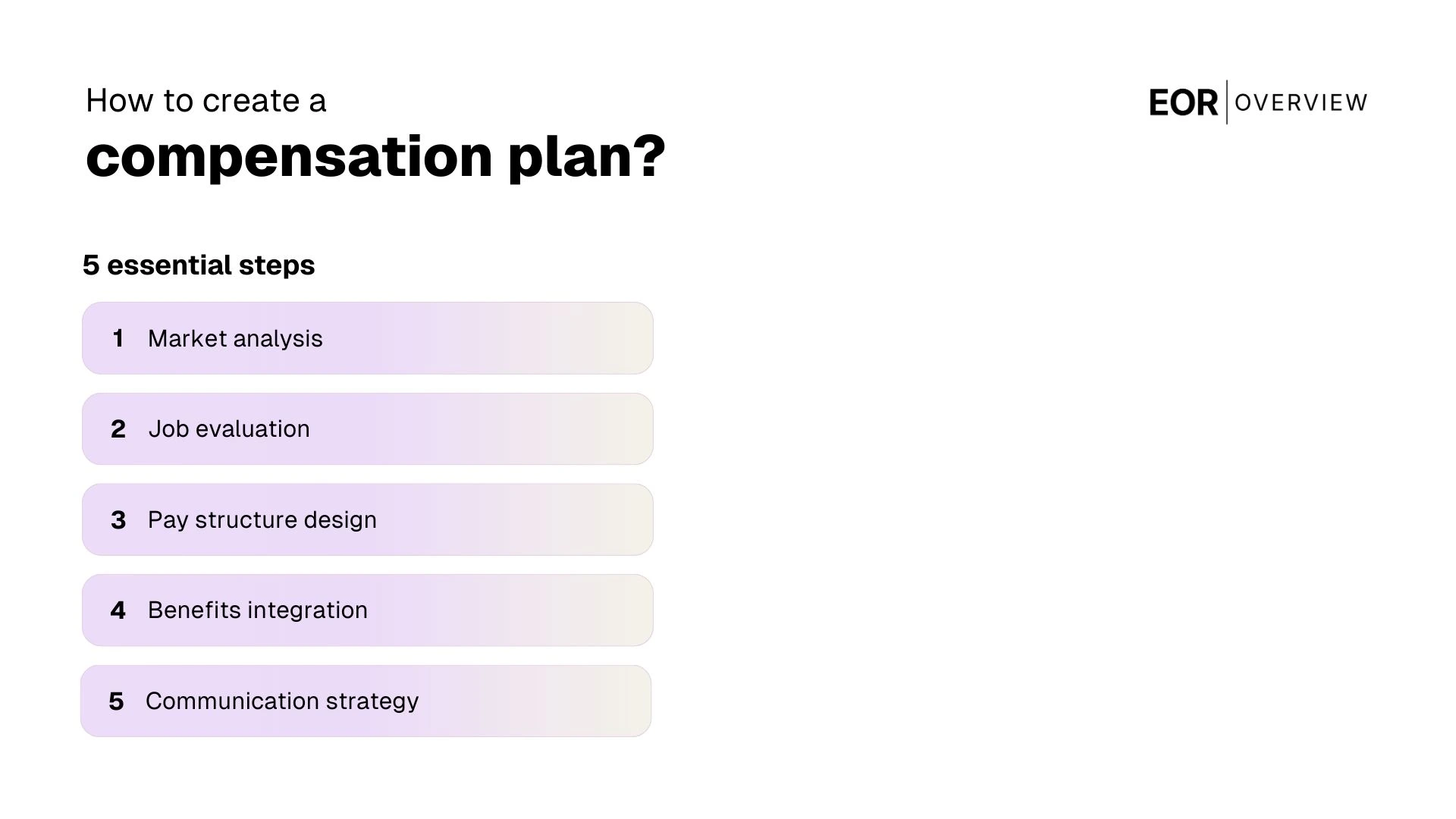Compensation planning is a systematic approach to designing and managing total reward packages that align employee value with organizational goals while maintaining market competitiveness and budget constraints.
In today's hyper-competitive landscape, especially within tech, finance, and startup environments, your compensation strategy directly impacts your ability to scale teams, retain critical talent, and maintain operational efficiency. A well-structured compensation plan becomes your competitive advantage, enabling you to attract the right talent while optimizing your human capital investment for sustainable growth.
Organizations with strategic compensation planning report significantly higher employee retention rates and improved performance outcomes, making it an essential capability for hiring managers and HR leaders navigating the evolving talent marketplace.
What is compensation planning?
Compensation planning is a strategic process that organizations use to design, implement, and manage their total compensation packages to attract and retain top talent. This comprehensive approach goes beyond basic salary considerations to encompass the entire spectrum of employee rewards and benefits.
At its core, a well-structured compensation plan balances direct compensation elements like base pay and bonus structures with indirect compensation components such as health benefits, retirement contributions, and equity offerings. This holistic view ensures that your compensation strategy aligns with both organizational goals and employee expectations.
Modern HR teams recognize that effective compensation planning requires a clear compensation philosophy that defines how the organization positions itself in the market. Whether you're offering performance-based incentive programs or comprehensive benefits packages, understanding the various types of compensation available helps create competitive offerings that drive employee engagement and business success.
What are the types of compensation?
Understanding the types of compensation is essential for developing a strong compensation plan that attracts top talent and reduces turnover. Modern compensation management requires employers to balance both direct and indirect elements to create competitive compensation packages that drive results.
The two primary types of compensation work together to form a comprehensive strategic compensation approach. These categories include direct compensation and indirect compensation, each serving distinct purposes in your overall talent strategy.
Direct compensation: This includes all monetary payments made directly to employees, such as base salary, hourly wages, bonuses, commissions, and stock options. The salary range for each position forms the foundation of direct compensation and must be both equitable and market-competitive to attract quality candidates.
Indirect compensation: These are non-monetary benefits that add value to the employee experience, including health insurance, retirement plans, paid time off, professional development opportunities, and flexible work arrangements. Indirect compensation often differentiates your employer brand and supports long-term retention goals.
Both types must work together to create equitable compensation structures that meet your objective of building a motivated, high-performing workforce while maintaining budget control.
Why employers need a compensation plan?
A well-structured compensation plan helps organizations establish fair and equitable compensation practices that drive business success. Without a strategic approach to compensation, companies struggle to attract and retain talent in today's competitive market, particularly in tech and finance sectors where skilled professionals have numerous options.
An equitable compensation plan addresses talent acquisition challenges, ensures pay equity compliance, supports employee retention, drives performance alignment, and maintains budget control. These benefits are listed in detail below.
Talent acquisition advantage: A compensation plan that attracts top performers includes competitive base salary ranges, performance bonuses, and stock options that differentiate your organization from competitors.
Pay equity compliance: Structured compensation practices ensure fair compensation across all demographics, reducing legal risks and supporting diversity initiatives in your workforce.
Employee retention strategy: Fair and equitable compensation reduces turnover costs and maintains institutional knowledge within your organization.
Performance alignment: When compensation refers to clear performance metrics, employees understand how their contributions directly impact their earnings potential.
To create a compensation framework that scales with your startup's growth, establish salary bands early and review them quarterly. This approach helps you attract top talent while maintaining budget predictability as you expand your workforce.

What are the benefits of compensation plans?
Strategic compensation planning allows organizations to unlock significant advantages that extend far beyond basic salary structures. The benefits of compensation include enhanced talent retention, improved performance alignment, and stronger competitive positioning in the market.
A well-designed compensation program serves as both a business strategy tool and an employee engagement driver. When you create a compensation plan that aligns with organizational goals, it transforms how your workforce performs and commits to company success. These benefits are listed in detail below.
Talent retention and reduced turnover: Effective compensation planning process helps reduce turnover by ensuring employees feel valued and fairly compensated, saving recruitment and training costs while maintaining institutional knowledge.
Performance motivation and alignment: Strategic compensation decisions motivate employees by linking rewards to specific outcomes, creating clear pathways for advancement and recognition.
Competitive market positioning: A comprehensive approach that includes employee benefits and competitive base pay helps attract top talent in competitive industries like tech and finance.
Budget predictability and cost control: Structured compensation planning allows organizations to forecast labor costs accurately while ensuring resources are allocated efficiently across departments and roles.

How to create a compensation plan?
Creating an effective compensation plan requires a systematic approach that balances organizational goals with employee expectations. HR professionals must consider multiple factors when designing a compensation structure that attracts top talent while maintaining budget constraints.
The essential steps include conducting market research, defining job roles, establishing pay grades, creating benefit packages, and implementing performance metrics. These steps ensure aligning compensation with both market standards and company objectives.
Market analysis: Research competitive salaries within your industry and geographic location to establish baseline compensation ranges that attract qualified candidates.
Job evaluation: Define clear job descriptions and responsibilities to determine appropriate compensation levels for each role within your organization.
Pay structure design: Create salary bands and grade levels that provide room for growth while ensuring internal equity among existing employees.
Benefits integration: Develop comprehensive pay and benefits packages that include benefits like health insurance, retirement plans, and professional development opportunities.
Communication strategy: Ensure employees understand the compensation philosophy and how their pay relates to performance and career progression.
Remember that direct compensation refers to base salary and bonuses, but employees value the total package. Consider different types of compensation including flexible work arrangements and career development opportunities, as employees who feel fairly compensated are less likely to leave.
Organizations need compensation planning that evolves with market conditions and business growth. Regular reviews and adjustments ensure your compensation strategy remains competitive and supports long-term talent retention goals.
What are the pillars of a strong compensation plan foundation?
A thorough compensation plan rests on four foundational pillars that ensure fair and equitable compensation across your organization: market alignment, internal equity, performance differentiation, and total rewards integration. These pillars work together to create an effective compensation strategy that attracts top talent while maintaining fiscal responsibility.
These pillars are essential for proper compensation management and form the backbone of any successful compensation planning process.
Market alignment: Ensures your compensation packages remain competitive by benchmarking against industry standards and global compensation trends, particularly crucial for tech and finance roles where talent competition is fierce.
Internal equity: Maintains fairness across similar roles and experience levels within your organization, preventing pay disparities that can lead to retention issues and legal compliance concerns.
Performance differentiation: Links compensation to measurable outcomes and career progression, allowing high performers to see clear financial rewards for their contributions.
Total rewards integration: Balances direct and indirect compensation elements including base salary, bonuses, equity, benefits, and professional development opportunities to create comprehensive value propositions.
How to ensure equity and fairness in a compensation plan?
Compensation planning ensures fairness through systematic evaluation and transparent structures. Start creating your compensation framework by establishing clear role or level definitions that align with market standards and internal equity principles.
The primary approaches include market benchmarking, internal pay equity analysis, performance-based compensation alignment, and comprehensive benefits evaluation. These strategies work together to create fair and competitive compensation structures.
Market benchmarking: Compare direct compensation against industry standards to ensure competitive positioning while examples of direct compensation include base salary, bonuses, and commissions.
Internal equity analysis: Review compensation across similar roles to identify and address pay gaps that may exist within your organization.
Performance alignment: Design plan based metrics that reward high performers fairly while maintaining consistent standards across teams.
Total rewards assessment: Evaluate how indirect compensation includes benefits such as health insurance, mental care plans, and retirement savings plans to create comprehensive value propositions.
Making compensation decisions without regular equity audits can expose your organization to legal risks and damage employee trust. Conduct annual reviews to identify potential disparities before they become compliance issues.
Streamline compensation management by implementing technology solutions that track pay equity metrics and automate reporting. This approach helps manage compensation consistently while providing data-driven insights for future planning decisions.

